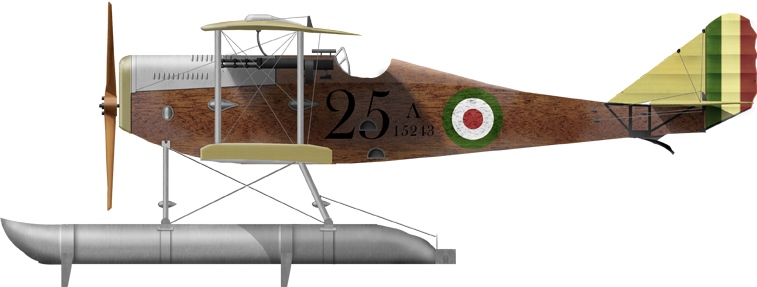
The Ansaldo SVA was a famous utility aircraft of the Italian Aviation in WW1, actually the fastest and most produced. It lacked agility for a proper fighter but took many other roles. In 1918 the SVA 4 was chosen to be converted as a floatplane, and the SVA 5 were chosen as a base for a production of 50. They were dedicated to the local air defence of major Regia Marina harbours, such as La Spezia, Taranto, Brindisi, and Venice, as well as to patrol at sea. They used tubular floats with hydroplanes fins, much as hydrofoils. The Regia Marina also operated the S.V.A. Am (Ansaldo Marino) with keeled-type floats as two-seaters. Two ISVA were also sold to Brazil in 1919 and helped training pilots of the Brazilian naval aviation school.
The company left a massive amrk in the history of Italian aviation, but started when Italy was at war, and to provide for the war effort's needs. The very first model was an Ansaldo Baby (1915) single seat biplane reconnaissance floatplane, copy under licence of the British Sopwith Baby. Then came the first truly national design, Ansaldo A.1 Balilla (1917) a sucessful single-engine one-seat fighter and the Ansaldo SVA.1 (1917) Single-engine one-seat biplane utility aircraft, usable as fighter, and also for reconnaissance and attack. It became soon the most produced Italian fighter of WWI, going through the SVA.2 to SVA.10.
The company also produced the A.120 Parasol reconnaissance fighter, A.300 (1919) Single-engine two-seat biplane utility aircraft, AC.1 (Dewoitine D.1 parasol fighter copy) AC.2 (1922) and AC.3 (1924) licence-built D.9 as well as the AC.4 (1927).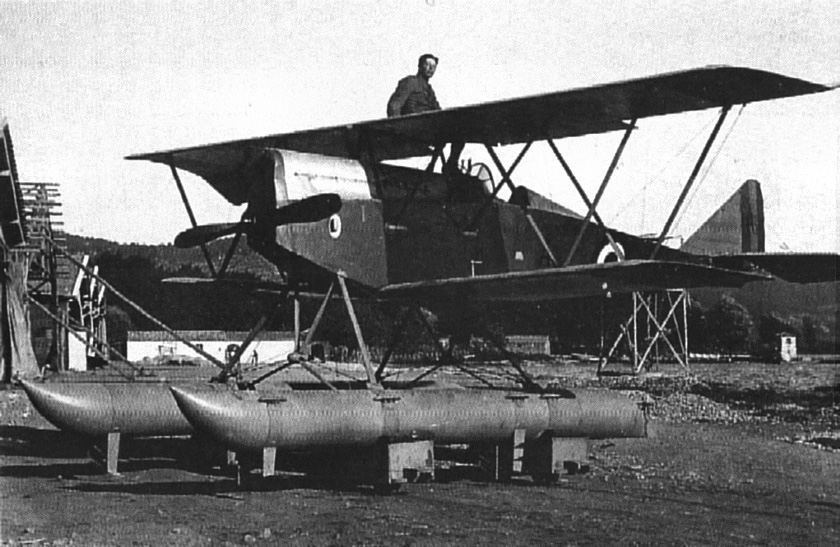
I S.V.A. 1st serie. The tubular floats were invented by A. Guidoni.
The Ansaldo S.V.A. ("Savoia-Verduzio-Ansaldo") was a family of Italian reconnaissance/utility single seat biplanes in World War I, still in use a decade after and two decades for some countries. Originally conceived as a fighter, the SVA was found inadequate for that role despite its impressive speed, range and operational ceiling. It was among the fastest of all Allied combat aircraft and proved to be an excellent reconnaissance aircraft and light bomber, but had a mediocre agility at best. This did not prevented its use as such when the occasion arose. Production continued well after the war, including under licence by other countries, and it was largely exported.
The SVA ws included in a stunt: A propaganda flight over Vienna inspired by Italian nationalist and poet Gabriele d'Annunzio. 11 Ansaldo SVAs did this on 9 August 1918 by the 87th Squadriglia "La Serenissima" from San Pelagio. At least two were two-seat SVA.9 or SVA.10s with d'Annunzio on board to leaad the flights and the rest being SVA.5 single-seaters.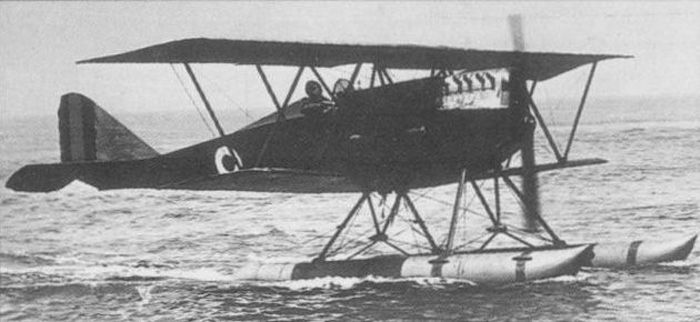
ISVA taxiing off La Spezia 1918
The SVA.2 (65 produced) led to the further development of the ISVA. The I stands for "Idroplane", added to S.V.A. It was also sometimes called the SVA "idro". It was a float-equipped version, 50 built for Regia Aeronautica and Italian Navy (Regia Marina)*. The first 4 prototypes were called S.V., then S.V.A.1, distinguished by the absence of a windshield and different upper wing-fuselage bracing as well as different exhaust arrangement.
The S.V.A.2 was the first production model, with modified bracing and exhausts, and an intermediate series showed a five-panel transparent windshield whereas the machine gun was installed on the upper wing. There was for this a semicircular opening in the upper wing as well as between the root and trailing edge of the lower wings, to improve pilot visibility upwards and downwards. The last series had a machine gun firing through the propeller and fairings for the attachment of the wing-fuselage struts.
The I.S.V.A. was a seaplane derived from the later S.V.A.4 and S.V.A.5. It was developed in collaboration of Alessandro Guidoni and the first prototype was tested by Mario Stoppani at the end of 1917. The first built had two simple tubular floats, later replaced by more modern keeled floats. What was remarkable, was the use for the first time of hydroplane fins, similar to those of hydrofoils, tested on the tubular floats. This was an intuition of Guidoni himself and actually helped when gaining speed to the transition towards flight.
This converted model was a single-seat float fighter version (the "I” prefix is for "Idro", water) started with the prototype built at La Spezia in 1918, a famous Italian naval base on the northwest coast, north of Pisa. It was powered by the same 205 hp SPA 6A engine used on regular land based models, with an armament consisting of two synchronised 7,7-mm Vickers machine guns. A total of fifty I.S.V.A. fighters was reported manufactured by all sources at La Spezia. They were used for the defence of other important naval bases (Like Taranto and Brindisi) and for coastal reconnaissance, notably int the Adriatic. Of course compared to the regular SVA.5, speed was not as impresive due to the drag caused by the two floats.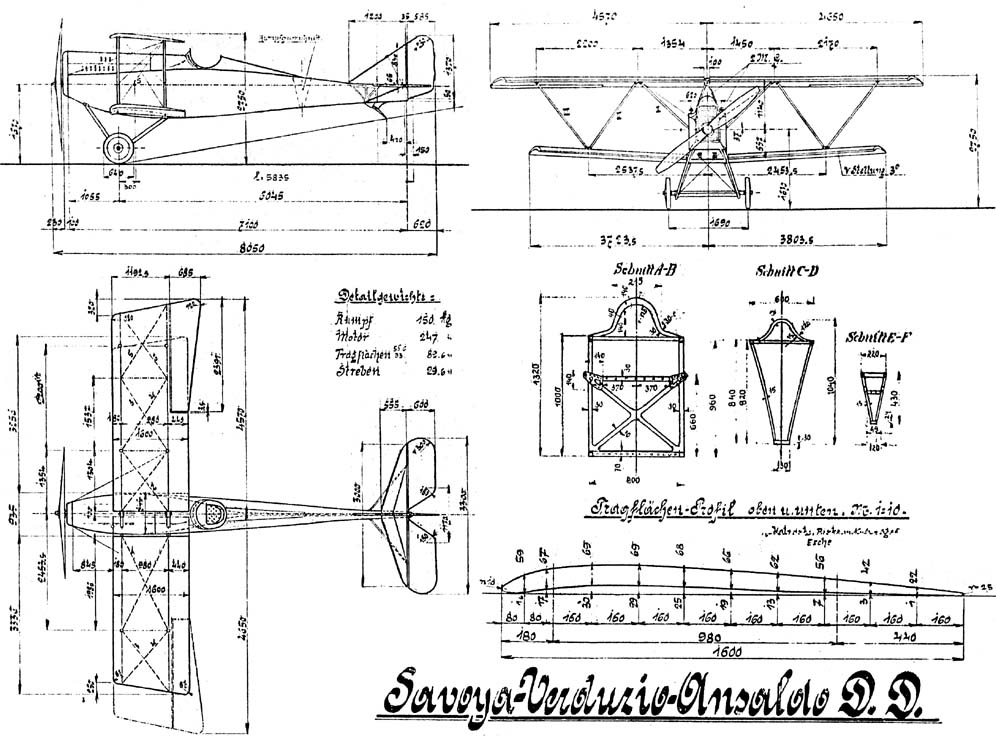
Drawing of a regular SVA
The SVA was a conventionally laid-out unequal-span biplane. Ut had unusual Warren Truss-style struts, joining the wings in that they had no transverse (spanwise) bracing wires. The fuselage was in plywood for the skin, on a mixed construction tubular structure using the typical Ansaldo's triangular rear cross-section, just behind the cockpit. This morphed into a rectangular cross section on the rear cockpit area and then a full rectangular cross section forward of the cockpit.
Two minor variants of the ISVA were produced: One with reconnaissance cameras, One with extra fuel tanks (and no cameras). The ISVA was capable of a top speed of 121 mph (195 km/h) at sea level as well as 112 mph (180 km/h) at 6,560 ft (2 000 m) and a 3 hrs. Its empty weight was 1,936 lb (878 kg) and 2,425 lb(1 100 kg) max take off weight, and it was a sesquiplane with a much larger upper wings and reduced lower wing, but the ratio between the fuselage and wings span talk by themselves, with a 29 ft 10 1/4 in (9,10 m) span for a 30 ft 6 1/8 in (9,30 m) fuselage. Yes, the SVA was longer than its span, which traduced less extra drag from the wings, translated into speed, but not agility. It was 12 ft 1 2/3 in (3,70 m) in eight with a typical triangular shaped tail. The total wing area was 263.72 sq ft (24,5 m2).
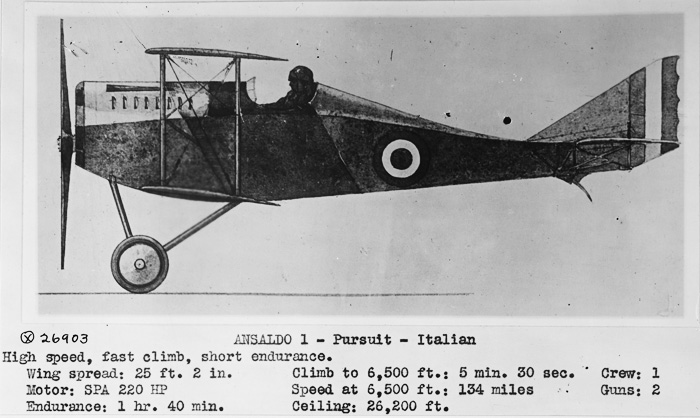
The USAAS and USN both tested the SVA in 1918
Italian designers Savoia and Verdusio teamed up with the Ansaldo factory to produce an utility reconnaissance model but originally a fighter, called the S.V.A. (Savoia, Verdusio, Ansaldo). It was ready in 1917 and very fast for its time (220 km/h) maneuverability was too much of a major shortcoming as a fighter. In some way it was comparable to the French SPAD, albeit the latter was far more agile. Of this serie, none was most successful was the S.V.A. 5. certainly the most common in production (or a total of 1,245). However also in 1918, a series of 50 S.V.A. floatplanes were produced as the Idro-S.V.A (3).
The Corpo Aeronautico Militare urged that the new SVA be provided in vast quantities adn Anslado, known for its manufacturing ability, radically improved production output. From only 65 aircraft completed by the end of 1917, 1,183 SVAs were manufactured for 1918 alone, making it the second-most numerous aircraft ever by the Italian aviation industry. By late 1917 and early 1918, licences were issued to other aircraft manufacturers for an even greater collective production. Some performed modifications such as reducing the length and span of the wings to increase speed further.
After few months of operation, twin-seater aircraft such as the SVA.9 were developed to make a better reconnaissance model, usually powered by the SPA 6A engine and also used as a trainer. The SVA.10 (Isotta engine) was powerful enough to make for a light bomber and reconnaissance model with a fixed forward MG and rear flexible Lewis gun for the observer.
The other great variant was the seaplane version, single-seat. However close to the end of the war, a two-seater version was produced for the Regia Marina, called S.V.A. Am (Ansaldo Marino) with the same keeled-type floats. Three ISVAs arrived by February 1918 at the 260th Squadron. On 1 June it had four SVA seaplanes, but they were not used due to poor reliability. In July they were sent back to the company for overhaul. One I SVA in the following summer at the 272nd Squadron performed missions and proved the concept.
The Ansalso Story
The company was founded in 1853 as Gio. Ansaldo & C. S.A.S. by Genoese businessment, Giovanni Ansaldo, Raffaele Rubattino, Giacomo Filippo Penco and Carlo Bombrini. By the late 19th century, the company focused on manufacturing and repairing railway components but it grew to a 10,000-worker company with seven factories, expanding into shipbuilding and mechanical works at large.The company left a massive amrk in the history of Italian aviation, but started when Italy was at war, and to provide for the war effort's needs. The very first model was an Ansaldo Baby (1915) single seat biplane reconnaissance floatplane, copy under licence of the British Sopwith Baby. Then came the first truly national design, Ansaldo A.1 Balilla (1917) a sucessful single-engine one-seat fighter and the Ansaldo SVA.1 (1917) Single-engine one-seat biplane utility aircraft, usable as fighter, and also for reconnaissance and attack. It became soon the most produced Italian fighter of WWI, going through the SVA.2 to SVA.10.
The company also produced the A.120 Parasol reconnaissance fighter, A.300 (1919) Single-engine two-seat biplane utility aircraft, AC.1 (Dewoitine D.1 parasol fighter copy) AC.2 (1922) and AC.3 (1924) licence-built D.9 as well as the AC.4 (1927).
The Ansaldo SVA

I S.V.A. 1st serie. The tubular floats were invented by A. Guidoni.
The Ansaldo S.V.A. ("Savoia-Verduzio-Ansaldo") was a family of Italian reconnaissance/utility single seat biplanes in World War I, still in use a decade after and two decades for some countries. Originally conceived as a fighter, the SVA was found inadequate for that role despite its impressive speed, range and operational ceiling. It was among the fastest of all Allied combat aircraft and proved to be an excellent reconnaissance aircraft and light bomber, but had a mediocre agility at best. This did not prevented its use as such when the occasion arose. Production continued well after the war, including under licence by other countries, and it was largely exported.
The SVA ws included in a stunt: A propaganda flight over Vienna inspired by Italian nationalist and poet Gabriele d'Annunzio. 11 Ansaldo SVAs did this on 9 August 1918 by the 87th Squadriglia "La Serenissima" from San Pelagio. At least two were two-seat SVA.9 or SVA.10s with d'Annunzio on board to leaad the flights and the rest being SVA.5 single-seaters.
Conversion of a successful Design

ISVA taxiing off La Spezia 1918
The SVA.2 (65 produced) led to the further development of the ISVA. The I stands for "Idroplane", added to S.V.A. It was also sometimes called the SVA "idro". It was a float-equipped version, 50 built for Regia Aeronautica and Italian Navy (Regia Marina)*. The first 4 prototypes were called S.V., then S.V.A.1, distinguished by the absence of a windshield and different upper wing-fuselage bracing as well as different exhaust arrangement.
The S.V.A.2 was the first production model, with modified bracing and exhausts, and an intermediate series showed a five-panel transparent windshield whereas the machine gun was installed on the upper wing. There was for this a semicircular opening in the upper wing as well as between the root and trailing edge of the lower wings, to improve pilot visibility upwards and downwards. The last series had a machine gun firing through the propeller and fairings for the attachment of the wing-fuselage struts.
The I.S.V.A. was a seaplane derived from the later S.V.A.4 and S.V.A.5. It was developed in collaboration of Alessandro Guidoni and the first prototype was tested by Mario Stoppani at the end of 1917. The first built had two simple tubular floats, later replaced by more modern keeled floats. What was remarkable, was the use for the first time of hydroplane fins, similar to those of hydrofoils, tested on the tubular floats. This was an intuition of Guidoni himself and actually helped when gaining speed to the transition towards flight.
This converted model was a single-seat float fighter version (the "I” prefix is for "Idro", water) started with the prototype built at La Spezia in 1918, a famous Italian naval base on the northwest coast, north of Pisa. It was powered by the same 205 hp SPA 6A engine used on regular land based models, with an armament consisting of two synchronised 7,7-mm Vickers machine guns. A total of fifty I.S.V.A. fighters was reported manufactured by all sources at La Spezia. They were used for the defence of other important naval bases (Like Taranto and Brindisi) and for coastal reconnaissance, notably int the Adriatic. Of course compared to the regular SVA.5, speed was not as impresive due to the drag caused by the two floats.
Engine & Performances of the Idro-SVA

Drawing of a regular SVA
The SVA was a conventionally laid-out unequal-span biplane. Ut had unusual Warren Truss-style struts, joining the wings in that they had no transverse (spanwise) bracing wires. The fuselage was in plywood for the skin, on a mixed construction tubular structure using the typical Ansaldo's triangular rear cross-section, just behind the cockpit. This morphed into a rectangular cross section on the rear cockpit area and then a full rectangular cross section forward of the cockpit.
Two minor variants of the ISVA were produced: One with reconnaissance cameras, One with extra fuel tanks (and no cameras). The ISVA was capable of a top speed of 121 mph (195 km/h) at sea level as well as 112 mph (180 km/h) at 6,560 ft (2 000 m) and a 3 hrs. Its empty weight was 1,936 lb (878 kg) and 2,425 lb(1 100 kg) max take off weight, and it was a sesquiplane with a much larger upper wings and reduced lower wing, but the ratio between the fuselage and wings span talk by themselves, with a 29 ft 10 1/4 in (9,10 m) span for a 30 ft 6 1/8 in (9,30 m) fuselage. Yes, the SVA was longer than its span, which traduced less extra drag from the wings, translated into speed, but not agility. It was 12 ft 1 2/3 in (3,70 m) in eight with a typical triangular shaped tail. The total wing area was 263.72 sq ft (24,5 m2).
Armament:
The ISVA was usable for recce and attack. For this it was equipped with a pair of Vickers 7.7 mm machine guns in the nose, synchronized with the propeller. The other utility was the use of bomb racks under the wings, to carry up to four 46 kgs bombs.Detailed specs
Specs ISVA | |
| Crew: | One pilot |
| Fuselage Lenght | 9.30 m |
| Wingspan: | 9.10 m |
| Wing area: | 24.48 m² |
| Empty weight: | 770 kg |
| Max TO weight: | 995 kg |
| Powerplant: | SPA 6A engine rated for 205 HP |
| Propeller: | 1 wooden 2 bladed, fixed pitch |
| Maximum speed: | 200 km/h |
| Endurance: | 2 h 30 min |
| Service ceiling: | 6,000 m |
| Armament: | 2x Vickers 7,7 mm, 184 kg Bombs (4x 46 kg) |
In action

The USAAS and USN both tested the SVA in 1918
Italian designers Savoia and Verdusio teamed up with the Ansaldo factory to produce an utility reconnaissance model but originally a fighter, called the S.V.A. (Savoia, Verdusio, Ansaldo). It was ready in 1917 and very fast for its time (220 km/h) maneuverability was too much of a major shortcoming as a fighter. In some way it was comparable to the French SPAD, albeit the latter was far more agile. Of this serie, none was most successful was the S.V.A. 5. certainly the most common in production (or a total of 1,245). However also in 1918, a series of 50 S.V.A. floatplanes were produced as the Idro-S.V.A (3).
The Corpo Aeronautico Militare urged that the new SVA be provided in vast quantities adn Anslado, known for its manufacturing ability, radically improved production output. From only 65 aircraft completed by the end of 1917, 1,183 SVAs were manufactured for 1918 alone, making it the second-most numerous aircraft ever by the Italian aviation industry. By late 1917 and early 1918, licences were issued to other aircraft manufacturers for an even greater collective production. Some performed modifications such as reducing the length and span of the wings to increase speed further.
After few months of operation, twin-seater aircraft such as the SVA.9 were developed to make a better reconnaissance model, usually powered by the SPA 6A engine and also used as a trainer. The SVA.10 (Isotta engine) was powerful enough to make for a light bomber and reconnaissance model with a fixed forward MG and rear flexible Lewis gun for the observer.
The other great variant was the seaplane version, single-seat. However close to the end of the war, a two-seater version was produced for the Regia Marina, called S.V.A. Am (Ansaldo Marino) with the same keeled-type floats. Three ISVAs arrived by February 1918 at the 260th Squadron. On 1 June it had four SVA seaplanes, but they were not used due to poor reliability. In July they were sent back to the company for overhaul. One I SVA in the following summer at the 272nd Squadron performed missions and proved the concept.
The Brazilian ISVAs
The Brazilian Navy made a significant effort to implement aviation and just five years after Santos Dumont's pioneering flight in 1911, on April 29, 1911, Navy Lieutenant Jorge Henrique Moller received his pilot's license in France, first Brazilian naval officer qualified as apilot. On October 14 the Brazilian Aeroclub is founded and Brazilian Naval Aviation really took off on August 23, 1916, when President Wenceslau Braz creates by decree the Naval Aviation School (EAvN), birthplace of the Brazilian combat aviation, and Navy's Aviation. From the old Navy Arsenal it was transferred to Enxadas Island. It flew Curtiss Model F 1914 flying boats, and started to graduate aviators on October, 27 students, 4 from the Army. However the next August these models were now worn out and obsolete so the Ministry of the Navy started to seek alternatives.Until the end of 1918, acquisition of new models and exchange between aviation professionals became easier and in 1919 the Brazilian naval aviation managed to keep and active fleet of 14 aircraft, which practically doubled. Nine were of Italian origin. Two were of Ansaldo Idro-S.V.A. floatplanes. These had a very short history at the Aviation School. In 1920, No. 27 was no longer listed and in 1921, No. 26 was undergoing repairs and soon discarded as well.
These two Ansaldo ISVA arrived disassembled, transported by sea in the first quarter of 1919. The first became N°26, assembled in August and N°27 assembled in November. It is speculated they were supplied with interchangeable conventional landing gear system adn due to their speed, were intended for advanced training as part of the Naval Aviator Course. However they would not present agility of performances that would gain trust from students or instructors. One ISVA had an accident and its remains were collected and dumped in the workshops of the Naval Aviation School. A reported pleaded for their land-based conversion. This was dismissioned as the airfield lacked facilities for operation of land-based aircraft. The pair was eventually dismantled in the workshops and decommission in 1921, still stored. One was ultimately returned to land-based use when spare parts for the new Ansaldo SVA-10s arrived in 1923. The SVA.10 also had a fair share of issues, notably due to the climate of Brazil.
Gallery

ISVA #15243 in 1918
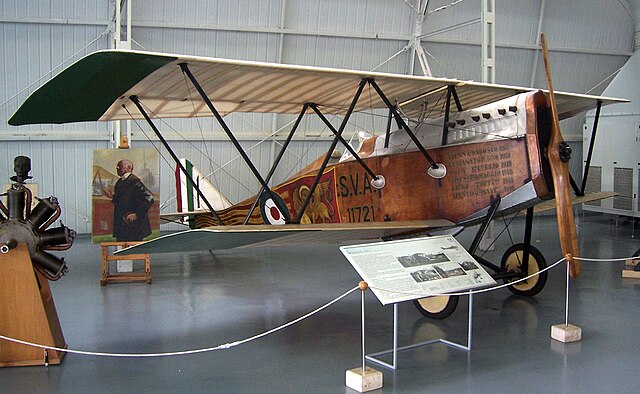
SVA 5 in a museum today, Venice squadron "La Serenessima"

SVA 5

Un I S.V.A. of the 1st serie with photo equipment and its tubular floats

Model of La Spezia squadron, On pinterest
Sources
J.Davilla - Italian Aviation in the First World War. Vol.2: Aircraft A-H /Centennial PerspectiveAlegi, Gregory (1993). Ansaldo SVA 5 (No. 40). Windsock Datafile. Berkhamsted: Albatros Productions.
"A–Z of Aircraft: Ansaldo A.300, Ansaldo SVA-5 & SVA-9 (No. 889 Sheet 62)". World Aircraft Information Files
Cattaneo, Gianni (1966). The S.V.A. (Ansaldo) Scouts. Profile Publications (No. 61). Surrey: Profile Publications.
Munson, Kenneth (1967). Aircraft of World War I. London: Ian Allan.
Taylor, Michael J. H. (1989). Jane's Encyclopedia of Aviation.
armedconflicts.com
armasnacionais.com/
naval.com.br
cmpr.it
aviastar.org
aeronavale.org les-avions/ansaldo-isva
Plan on flyingmachines.ru
Plan on flyingmachines.ru
Plan on flyingmachines.ru
flyingmachines.ru
/it.wikipedia.org
airwar.ru
- Lohner E (1913)
- Macchi M3 (1916)
- Macchi M5 (1918)
- Ansaldo ISVA (1918)
- Sopwith Baby (1916)
- Short 184 (1916)
- Fairey Campania (1917)
- Sopwith Cuckoo (1917)
- Felixstowe F.2 (1917)
- Friedrichshafen FF 33 (1916)
- Albatros W4 (1916)
- Albatros W8 (1918)
- Hanriot HD.2
- Grigorovitch M5
- IJN Farman MF.7
- IJN Yokosho Type Mo
- Yokosho Rogou Kougata (1917)
- Yokosuka Igo-Ko (1920)
- Curtiss N9 (1916)
- Aeromarine 39
- Vought VE-7
- Douglas DT (1921)
- Boeing FB.5 (1923)
- Boeing F4B (1928)
- Vought O2U/O3U Corsair (1928)
- Blackburn Blackburn (1922)
- Supermarine Seagull (1922)
- Blackburn Ripon (1926)
- Fairey IIIF (1927)
- Fairey Seal (1930)
- LGL-32 C.1 (1927)
- Caspar U1 (1921)
- Dornier Do J Wal (1922)
- Rohrbach R-III (1924)
- Mitsubishi 1MF (1923)
- Mitsubishi B1M (1923)
- Yokosuka E1Y (1923)
- Nakajima A1N (1927)
- Nakajima E2N (1927)
- Mitsubishi B2M (1927)
- Nakajima A4N (1929)
- CANT 18
WW1
✠ K.u.K. Seefliegerkorps:
 Italian Naval Aviation
Italian Naval Aviation
 RNAS
RNAS
 Marineflieger
Marineflieger
 French Naval Aviation
French Naval Aviation
 Russian Naval Aviation
Russian Naval Aviation
 IJN Air Service
IJN Air Service
 USA
USA
Interwar
 Interwar US
Interwar US
 Interwar Britain
Interwar Britain
 Interwar France
Interwar France
 Interwar Germany
Interwar Germany
 Interwar Japan
Interwar Japan
 Interwar Italy
Interwar Italy
- Curtiss SOC seagull (1934)
- Grumman FF (1931)
- Curtiss F11C Goshawk (1932)
- Grumman F2F (1933)
- Grumman F3F (1935)
- Northrop BT-1 (1935)
- Grumman J2F Duck (1936)
- Consolidated PBY Catalina (1935)
- Brewster/NAF SBN-1 (1936)
- Curtiss SBC Helldiver (1936)
- Vought SB2U Vindicator (1936)
- Brewster F2A Buffalo (1937)
- Douglas TBD Devastator (1937)
- Vought Kingfisher (1938)
- Curtiss SO3C Seamew (1939)
- Douglas SBD Dauntless (1939)
- Grumman F4F Wildcat (1940)
- F4U Corsair (NE) (1940)
- Brewster SB2A Buccaneer (1941)
- Grumman TBF/TBM Avenger (1941)
- Consolidated TBY Sea Wolf (1941)
- Grumman F6F Hellcat (1942)
- Curtiss SB2C Helldiver (1942)
- Curtiss SC Seahawk (1944)
- Grumman F8F Bearcat (1944)
- Ryan FR-1 Fireball (1944)
- Douglas AD-1 Skyraider (1945)
Fleet Air Arm
- Fairey Swordfish (1934)
- Blackburn Shark (1934)
- Supermarine Walrus (1936)
- Fairey Seafox (1936)
- Blackburn Skua (1937)
- Short Sunderland (1937)
- Blackburn Roc (1938)
- Fairey Albacore (1940)
- Fairey Fulmar (1940)
- Grumman Martlet (1941)
- Hawker sea Hurricane (1941)
- Brewster Bermuda (1942)
- Fairey Barracuda (1943)
- Fairey Firefly (1943)
- Grumman Tarpon (1943)
- Grumman Gannet (1943)
- Supermarine seafire (1943)
- Blackburn Firebrand (1944)
- Hawker Sea Fury (1944)
IJN aviation
- Aichi D1A "Susie" (1934)
- Mitsubishi A5M "Claude" (1935)
- Nakajima A4N (1935)
- Yokosuka B4Y "Jean" (1935)
- Mitsubishi G3M "Nell" (1935)
- Nakajima E8N "Dave" (1935)
- Kawanishi E7K "Alf" (1935)
- Nakajima B5N "Kate" (1937)
- Kawanishi H6K "Mavis" (1938)
- Aichi D3A "Val" (1940)
- Mitsubishi A6M "zeke" (1940)
- Nakajima E14Y "Glen" (1941)
- Nakajima B6N "Jill" (1941)
- Mitsubishi F1M "pete" (1941)
- Aichi E13A Reisu "Jake" (1941)
- Kawanishi E15K Shiun "Norm" (1941)
- Nakajima C6N Saiun "Myrt" (1942)
- Yokosuka D4Y "Judy" (1942)
- Kyushu Q1W Tokai "Lorna" (1944)
Luftwaffe
- Arado 196 (1937)
- Me109 T (1938)
- Blohm & Voss 138 Seedrache (1940)
Italian Aviation
- Savoia-Marchetti S.55
- IMAM Ro.43/44
- CANT Z.501 Gabbiano
- CANT Z.506 Airone
- CANT Z.508
- CANT Z.511
French Aeronavale
- GL.300 (1926-39)
- Levasseur PL.5 (1927)
- Potez 452 (1935)
- Loire 210 (1936)
- Loire 130 (1937)
- LN 401 (1938)
Soviet Naval Aviation
- Shavrov SH-2 (1928)
- Tupolev TB-1P (1931)
- Beriev MBR-2 (1930)
- Tupolev MR-6 (1933)
- Tupolev MTB-1 (1934)
- Beriev Be-2 (1936)
- Polikarpov I16 naval (1936)
- Tupolev MTB-2 (1937)
- Ilyushine DB-3T/TP (1937)
- Beriev Be-4 (1940)
-
Skoda Š-328V
R-XIII Idro
Fokker C.XI W (1934)
WW2
- De Havilland Sea Vixen
- Hawker Sea Hawk
- Supermarine Scimitar
- Blackburn Buccaneer
- Hawker Sea Harrier
- Douglas A4 Skyhawk
- Grumman F9F Panther
- Vought F8 Crusader
- McDonnell-Douglas F-4 Phantom-II
- North Am. A5 Vigilante
- TU-142
- Yak 38 forger
☢ Cold War
✧ NATO
 Fleet Air Arm
Fleet Air Arm
 US Navy
US Navy
☭ Warsaw Pact
Merch

Seafire Mark 45; HMS Pretoria Castle

Zeros vs its aversaries

Aichi D3A “Val” Junyo

Mitsubishi A5M poster

F4F wildcat

Macchi M5

SBD Dauntless Coral Sea

SBD Dauntless USS Enterprise

SBD-4 CV22